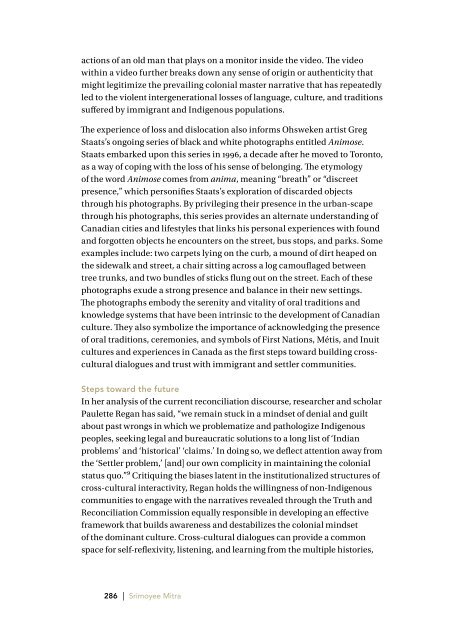Srimoyee Mitra - Speaking My Truth
Srimoyee Mitra - Speaking My Truth
Srimoyee Mitra - Speaking My Truth
- No tags were found...
You also want an ePaper? Increase the reach of your titles
YUMPU automatically turns print PDFs into web optimized ePapers that Google loves.
actions of an old man that plays on a monitor inside the video. The videowithin a video further breaks down any sense of origin or authenticity thatmight legitimize the prevailing colonial master narrative that has repeatedlyled to the violent intergenerational losses of language, culture, and traditionssuffered by immigrant and Indigenous populations.The experience of loss and dislocation also informs Ohsweken artist GregStaats’s ongoing series of black and white photographs entitled Animose.Staats embarked upon this series in 1996, a decade after he moved to Toronto,as a way of coping with the loss of his sense of belonging. The etymologyof the word Animose comes from anima, meaning “breath” or “discreetpresence,” which personifies Staats’s exploration of discarded objectsthrough his photographs. By privileging their presence in the urban-scapethrough his photographs, this series provides an alternate understanding ofCanadian cities and lifestyles that links his personal experiences with foundand forgotten objects he encounters on the street, bus stops, and parks. Someexamples include: two carpets lying on the curb, a mound of dirt heaped onthe sidewalk and street, a chair sitting across a log camouflaged betweentree trunks, and two bundles of sticks flung out on the street. Each of thesephotographs exude a strong presence and balance in their new settings.The photographs embody the serenity and vitality of oral traditions andknowledge systems that have been intrinsic to the development of Canadianculture. They also symbolize the importance of acknowledging the presenceof oral traditions, ceremonies, and symbols of First Nations, Métis, and Inuitcultures and experiences in Canada as the first steps toward building crossculturaldialogues and trust with immigrant and settler communities.Steps toward the futureIn her analysis of the current reconciliation discourse, researcher and scholarPaulette Regan has said, “we remain stuck in a mindset of denial and guiltabout past wrongs in which we problematize and pathologize Indigenouspeoples, seeking legal and bureaucratic solutions to a long list of ‘Indianproblems’ and ‘historical’ ‘claims.’ In doing so, we deflect attention away fromthe ‘Settler problem,’ [and] our own complicity in maintaining the colonialstatus quo.”9 Critiquing the biases latent in the institutionalized structures ofcross-cultural interactivity, Regan holds the willingness of non-Indigenouscommunities to engage with the narratives revealed through the <strong>Truth</strong> andReconciliation Commission equally responsible in developing an effectiveframework that builds awareness and destabilizes the colonial mindsetof the dominant culture. Cross-cultural dialogues can provide a commonspace for self-reflexivity, listening, and learning from the multiple histories,286 | <strong>Srimoyee</strong> <strong>Mitra</strong>
















